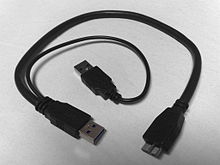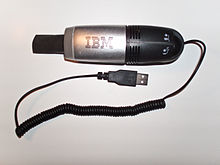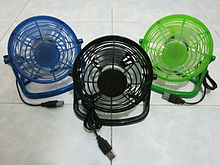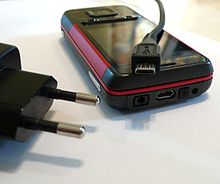USB Power
The USB 1.x and 2.0 specifications provide a 5 V supply on a single wire to power connected USB devices. The specification provides for no more than 5.25 V and no less than 4.75 V (5 V ± 5%) between the positive and negative bus power lines (VBUS voltage). For USB 3.0, the voltage supplied by low-powered hub ports is 4.45–5.25 V.
| Specification | Current | Voltage | Power |
|---|---|---|---|
| USB 1.0 USB 2.0 |
150 mA | 5 V | 0.75 W |
| 500 mA[a] | 5 V | 2.5 W | |
| USB 3.0 | 900 mA[b] | 5 V | 4.5 W |
| USB 3.1 | 2 A | 5 V | 10 W |
| 5 A | 12 V | 60 W | |
| 5 A | 20 V | 100 W | |
| USB Battery Charging | 0.5–1.5 A | 5 V | 2.5–7.5 W |
| USB Power Delivery | 2 A | 5 V | 10 W |
| 3 A | 12 V | 36 W | |
| 3 A | 20 V | 60 W | |
| 5 A | 20 V | 100 W | |
|
|||
 Y-shaped USB 3.0 cable; with such a cable, a device can draw power from two USB ports simultaneously |
A unit load is defined as 100 mA in USB 2.0, and 150 mA in USB 3.0. A device may draw a maximum of five unit loads (500 mA) from a port in USB 2.0, or six unit loads (900 mA) in USB 3.0. There are two types of devices: low-power and high-power. A low-power device (such as a USB HID) draws at most one-unit load, with minimum operating voltage of 4.4 V in USB 2.0, and 4 V in USB 3.0. A high-power device draws, at most, the maximum number of unit loads the standard permits. Every device functions initially as low-power (including high-power functions during their low-power enumeration phases), but may request high-power, and get it if available on the providing bus.
USB Power standards
Some devices, such as high-speed external disk drives, require more than 500 mA of current and therefore may have power issues if powered from just one USB 2.0 port: erratic function, failure to function, or overloading/damaging the port. Such devices may come with an external power source or a Y-shaped cable that has two USB connectors (one for power and data, the other for power only) to plug into a computer. With such a cable, a device can draw power from two USB ports simultaneously.However, USB compliance specification states that "use of a 'Y' cable (a cable with two A-plugs) is prohibited on any USB peripheral", meaning that "if a USB peripheral requires more power than allowed by the USB specification to which it is designed, then it must be self-powered."[72]
A bus-powered hub initializes itself at one-unit load and transitions to maximum unit loads after it completes hub configuration. Any device connected to the hub draws one-unit load regardless of the current draw of devices connected to other ports of the hub (i.e., one device connected on a four-port hub draws only one-unit load despite the fact that more unit loads are being supplied to the hub).
A self-powered hub supplies maximum supported unit loads to any device connected to it. In addition, the VBUS presents one-unit load upstream for communication if parts of the Hub are powered down.
Charging ports
The USB Battery Charging Specification Revision 1.1 (released in 2007) defines new types of USB ports, charging ports. As compared to standard downstream ports, where a portable device can only draw more than 100 mA current after digital negotiation with the host or hub, charging ports can supply currents between 500 mA and 1.5 A without digital negotiation. A charging port supplies up to 500 mA at 5 V, up to the rated current at 3.6 V or more, and drop its output voltage if the portable device attempts to draw more than the rated current. The charger port may shut down if the load is too high.
Two types of charging ports exist: charging downstream ports (CDP), supporting data transfers as well, and dedicated charging ports (DCP), without data support. A portable device can recognize the type of USB port; on a dedicated charging port, the D+ and D− pins areshorted with a predetermined resistance, while charging downstream ports provide additional detection logic so their presence can be determined by attached devices.
With charging downstream ports, current passing through the thin ground wire may interfere with high-speed data signals; therefore, current draw may not exceed 900 mA during high-speed data transfer. A dedicated charge port may have a rated current between 500 and 1,500 mA. For all charging ports, there is maximum current of 5 A, as long as the connector can handle the current (standard USB 2.0 A-connectors are rated at 1.5 A).
Before the battery charging specification was defined, there was no standardized way for the portable device to inquire how much current was available. For example, Apple's iPod and iPhone chargers indicate the available current by voltages on the D− and D+ lines. When D+ = D− = 2.0 V, the device may pull up to 500 mA. When D+ = 2.0 V and D− = 2.8 V, the device may pull up to 1 A of current.When D+ = 2.8 V and D− = 2.0 V, the device may pull up to 2 A of current.
Dedicated charging ports can be found on USB power adapters that convert utility power or another power source (e.g., a car's electrical system) to run attached devices and battery packs. On a host (such as a laptop computer) with both standard and charging USB ports, the charging ports should be labeled as such.
To support simultaneous charge and data communication, even if the communication port does not support charging a demanding device, so-called accessory charging adapters (ACA) are introduced. By using an accessory charging adapter, a device providing a single USB port can be attached to both a charger, and another USB device at the same time.
The USB Battery Charging Specification Revision 1.2 (released in 2010) makes clear that there are safety limits to the rated current at 5 A coming from USB 2.0. On the other hand, several changes are made and limits are increasing including allowing 1.5 A on charging downstream ports for unconfigured devices, allowing high speed communication while having a current up to 1.5 A, and allowing a maximum current of 5 A. Also, revision 1.2 removes support for USB ports type detection via resistive detection mechanisms.
Sleep-and-charge ports
Sleep-and-charge USB ports can be used to charge electronic devices even when the computer is switched off. Normally, when a computer is powered off, the USB ports are powered down. This prevents phones and other devices from being able to charge unless the computer is powered on. Sleep-and-charge USB ports remain powered even when the computer is off. On laptops, charging devices from the USB port when it is not being powered from AC drains the laptop battery faster; most laptops have a facility to stop charging if their own battery charge level gets too low. Desktop machines need to remain plugged into AC power for Sleep-and-charge to work.
 A yellow USB port denoting sleep-and-charge |
These ports are found colored differently (mostly red or yellow). On Dell laptops, the port is marked with the standard USB symbol with an added lightning bolt icon on the right side. Dell calls this feature "PowerShare."
On Acer Inc. and Packard Bell laptops, sleep-and-charge USB ports are marked with a non-standard symbol (the letters "USB" over a drawing of a battery); the feature is simply called "Power-off USB".
Mobile device charger standards
In China
As of 14 June 2007, all new mobile phones applying for a license in China are required to use a USB port as a power port for battery charging.This was the first standard to use the convention of shorting D+ and D-.
|
The Micro-USB interface is commonly found on chargers formobile phones |
OMTP/GSMA Universal Charging Solution
In September 2007, the Open Mobile Terminal Platform group (a forum of mobile network operators and manufacturers such as Nokia,Samsung, Motorola, Sony Ericsson and LG) announced that its members had agreed on micro-USB as the future common connector for mobile devices.
The GSM Association (GSMA) followed suit on 17 February 2009,and on 22 April 2009, this was further endorsed by theCTIA – The Wireless Association,with the International Telecommunication Union (ITU) announcing on 22 October 2009 that it had also embraced the Universal Charging Solution as its "energy-efficient one-charger-fits-all new mobile phone solution", and added: "Based on the Micro-USB interface, UCS chargers will also include a 4-star or higher efficiency rating—up to three times more energy-efficient than an unrated charger."
EU Smartphone Power Supply Standard
Main article: Common External Power Supply
In June 2009, many of the world's largest mobile phone manufacturers signed an EC-sponsored Memorandum of Understanding (MoU), agreeing to make most data-enabled mobile phones marketed in the European Union compatible with a common External Power Supply (EPS). The EU's common EPS specification (EN 62684:2010) references the USB Battery Charging standard and is similar to the GSMA/OMTP and Chinese charging solutions.n January 2011, the International Electrotechnical Commission (IEC)released its version of the (EU's) common EPS standard as IEC 62684:2011.
Non-standard devices
Some USB devices require more power than is permitted by the specifications for a single port. This is common for external hard andoptical disc drives, and generally for devices with motors or lamps. Such devices can use an external power supply, which is allowed by the standard, or use a dual-input USB cable, one input of which is used for power and data transfer, the other solely for power, which makes the device a non-standard USB device. Some USB ports and external hubs can, in practice, supply more power to USB devices than required by the specification but a standard-compliant device may not depend on this.
In addition to limiting the total average power used by the device, the USB specification limits the inrush current (i.e., that used to charge decoupling and filter capacitors) when the device is first connected. Otherwise, connecting a device could cause problems with the host's internal power. USB devices are also required to automatically enter ultra low-power suspend mode when the USB host is suspended. Nevertheless, many USB host interfaces do not cut off the power supply to USB devices when they are suspended.

USB-powered mini fans

USB-powered mini fans
Some non-standard USB devices use the 5 V power supply without participating in a proper USB network, which negotiates power draw with the host interface. These are usually called USB decorations. Examples include USB-powered keyboard lights, fans, mug coolers and heaters, battery chargers, miniature vacuum cleaners, and even miniature lava lamps. In most cases, these items contain no digital circuitry, and thus are not standard compliant USB devices. This may cause problems with some computers, such as drawing too much current and damaging circuitry. Prior to the Battery Charging Specification, the USB specification required that devices connect in a low-power mode (100 mA maximum) and communicate their current requirements to the host, which then permits the device to switch into high-power mode.
Some devices, when plugged into charging ports, draw even more power (10 watts or 2.1 Amps) than the Battery Charging Specification allows. The iPad and MiFi 2200 are two such devices.Barnes & Noble NOOK Color devices also require a special charger that runs at 1.9 Amps.
USB Power Delivery
In July 2012 the USB Promoters Group announced the finalization of the USB Power Delivery ("PD") specification, an extension that specifies using certified "PD aware" USB cables with standard USB type A/B connectors to deliver up to 100 W of power at 20 V. For PD-aware cables with USB-micro B/AB connectors the maximum power supported is up to 60 W at 20 V, 36 W at 12 V and 10 W at 5 V. In all cases, either host-to-device or device-to-host configurations are supported.
The intent is to permit uniformly charging laptops, tablets, USB-powered disks and similarly higher power consumer electronics, as a natural extension of existing European and Chinese mobile telephone charging standards. This may also affect the way electric power used for small devices is transmitted and used in both residential and public buildings.
PoweredUSB
Main article: PoweredUSB
PoweredUSB is a proprietary extension that adds four additional pins supplying up to 6 A at either 5 V, 12 V, or 24 V. It is commonly used in point of sale systems to power peripherals such as barcode readers, credit card terminals, and printers.
